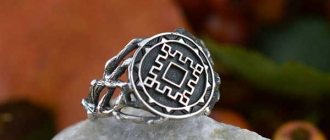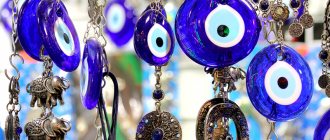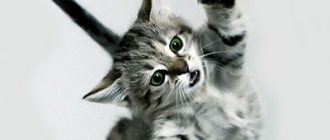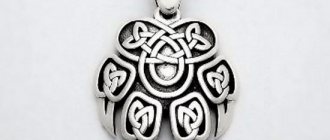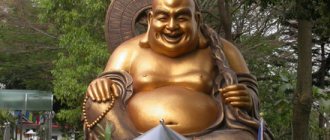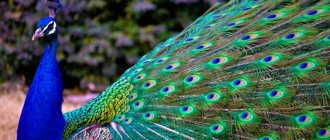In modern society, Eastern and Western cultures, religions, beliefs are mutually integrated and complement each other. However, when accepting various amulets, talismans, and amulets of other peoples, it is important to understand their history, purpose and action.
Dream catchers came to us from the Indians of North America. In many tribes, such as the Ojibwe, Navajo, Cree, Cherokee, Iroquois, etc., such wicker amulets were used to protect the home from disease and evil spirits. It was believed that evil spirits, illnesses and bad dreams became entangled in the woven web, while good spirits and good dreams could pass through holes in the pattern.
Origin and magical meaning of the amulet – Dream Catcher
The amulet became popular in the 60-70s. 20th century against the background of interest in ethnic, in particular Indian, subjects. A beautiful talisman in the form of a ring with a cobweb inside, decorated with beads and feathers, will appeal to lovers of interesting decor. However, in addition to its unusual appearance, this amulet also has magical properties.
As a sacred amulet, the dream catcher has been known since ancient times. Different tribes of North American Indians, as well as peoples of Siberia, had similar items. According to assumptions, amulets appeared in different parts of the world independently of each other.
The origin of the Siberian amulet remains unclear. It is only known that it was used by shamans to establish contact with the other world and receive signals from it through dreams. There are several legends regarding the appearance of North American varieties of dream catchers.
Similar amulets were present in several tribes at once: Ojibwe, Lakota, Cree, Huron, Navajo, Cherokee, Iroquois. Each of them considered their people to be the creators of the first catcher. Only recently has it been finally established that the right to primacy belongs to the Ojibwe.
All tribes have their own legends regarding the origin of the dream catcher. The most common of them:
- A Lakota elder once climbed to the top of a mountain and began to meditate . He saw a vision of a wise spirit in the form of a Spider, with whom the man was discussing the “circle of life.” The teacher told the elder that a newborn comes into the world, he grows up, has his own children, who also become older. Thus, the “circle of life” is endless and cyclical. During the conversation, Spider made a willow hoop as a symbol of this process. Inside he placed a web with a hole in the center. According to the Teacher, his creation symbolized the many roads encountered on the path of life. The right choices and thoughts should have led to the center of the web, while the wrong ones would have become entangled in the threads. The spider ordered the elder to use the amulet for protection in a dream, as a talisman against the encroachment of evil spirits, nightmares and bad thoughts. It was believed that negative dreams and thoughts get stuck in the weave, not finding their way to the center and burn out with the first rays of the sun.
- The Indian goddess Spider Woman, who connects all living things with the threads of her network and controls the Universe, was also the personification of maternal protection . She worried about the people of her tribe, cared about them. Every morning the goddess wove a web from dawn sparks and caught the sun, returning light and warmth to people. When the tribe grew and spread over great distances, she could no longer keep track of everyone. Therefore, the goddess ordered the Indians to make small cobwebs, enclosed in a circle of willow twigs, and hang them near the bed and on cradles. The design was supposed to weed out evil, nightmares, and return the sun to the house.
What types of dream catchers are there?
Dream catchers differ from each other in appearance. The difference is observed in the shape of the sacred object, the weaving technique, the number of threads and their attachment to the base. The differences are due to the fact that the author of each species was its own tribe, which had special traditions, rules for its creation, and sometimes the purpose was different. The main types of amulet, based on the form:
- round;
- spiral;
- three-dimensional;
- double;
- in the form of a doll.
Round amulets are the most common and are considered a classic version of catchers. Amulets of this type have a base hoop, inside of which threads are wound; sometimes there are additional attributes in the form of feathers, beads, stones, fur, pieces of plants, etc. The circle symbolizes the cyclical nature of life, infinity or the movement of the sun across the sky. There is also a division within this group:
- Ojibwe dream catchers. It is recognized that this tribe is the author of the first dream catchers. The spider was considered the patron spirit of the Ojibwe. Initially, animal sinews were used instead of threads. The weaving has an appearance very close to a real web, through which good dreams should penetrate.
Such amulets have a strictly regulated number of points for attaching threads to the hoop. There may be 7, 8 or 12 of them . In the first case, the number of dots symbolizes the 7 prophets from the tribal legend. If there are 8 fastenings, then this means the number of spider legs. 12 dots symbolize temporal cyclicity. The network can be without beads or with one, meaning a spider sitting in the network. There is only one feather, hanging on a thread from the center of the structure, or it is missing.
- Cree dreamcatchers . Generally similar to Ojibwe amulets. The weaving closely matches the natural web; there are no decorations.
- Navajo trappers . The most common option that can be seen everywhere. It is also the easiest to create yourself. Weaving is more reminiscent of a network; in the center there is always a hole for the passage of good dreams and thoughts to the owner. There may be a varying number of feathers, beads, and other decorations.
- Catchers Kytgyem (translated as “trap”). They are shamanic attributes of the peoples of Siberia. The weave includes 18 threads and has 36 attachment points to the hoop. The color of the fiber spokes can be dark blue or black, which symbolizes the Earth. The threads located on top of them are laid out in a spiral and have a red tone. They symbolize the movement of the midnight sun (the luminary in the land of dreams) across the sky.
The center of the weaving is shifted upward, from which comes a leather cord with fur tassels. Three similar threads come from the bottom of the hoop. A bait in the form of a piece of fur, leather, cloth soaked in blood, a tuft of wool, etc. is tied to the center. Figures of magical animals, stones, and beads can be placed in any quantity and area of the amulet.
This type of catcher is not intended to ward off any visions. His task is to collect energy, thoughts, manifestations of otherworldly influence during the daytime, strengthen them and transfer them to the shaman during sleep . A person receives a kind of enhanced dreams, including nightmares, in which he sees clues from the Universe that need interpretation, or develops strength and will.
- The spiral dream catcher is part of the Ojibwe culture. Its second name is “Seven Lights”, named after an Indian prophecy. It is believed that it symbolizes the stages of human development, the unity of people, as well as man and nature. This is an open amulet. The base has the shape of a spiral, weaving is done in the usual way. A cord is attached to the top, with a feather at the end. Can be decorated with various beads and figures. The bad gets entangled in the threads, the good goes down the cord to the sleeper.
- The three-dimensional catcher is a connection at right angles of 2 wooden hoops. Each of them contains a weaving network. Its second name is “two paths - one road.” It is considered a family amulet, made for a wedding or to enhance the protection of loving hearts. In this amulet, the power of two elements is collected into a single path that leads to happiness and harmony. Also, due to the fact that the halves of each of the rims face the 4 cardinal directions, it is assumed that their powers bestow their benefits on the family.
- A double dream catcher suggests that part of the hoop of one amulet overlaps the second. It is also possible to place a smaller hoop inside a larger one. It has a similar design to classic catchers, however, according to the Indians, its strength is twice that of a regular one.
- Catchers in the form of pupae are characteristic of Slavic peoples . They were made from fabric, folded in a special way into the shape of a person, or from wooden twigs, covered with a piece of fabric or threads. The amulets did not have a face painted on them; they could be decorated with colored ropes, tied on top of the branches. Catchers drove away nightmares, attracted good dreams, and were often used near children's beds.
Differences in amulets in different cultures
Dream catchers come in several types by origin, but all have common distinctive features:
- the circle is the main compositional detail, symbolizing the daily movement of the sun;
- feathers are a symbol of lightness and free breathing.
Today three types of amulets are known:
- Indian. It is a circle, inside of which there is a “web-like” mesh of threads. It captures bright dreams, directs them to the sleeper, and also holds back nightmares. Dark spirits carrying bad dreams become entangled in the net and die in the rays of the rising sun.
- Siberian. It is intended to attract both good and bad dreams, therefore it is used mainly by shamans, since any visions are important for a cult minister. In a dream, a shaman communicates with entities stuck in the “web” and asks them questions. It is better for ordinary people and inexperienced servants of pagan cults not to use such amulets, it can be dangerous.
- Asiatic. In addition to the main parts, it consists of various figures and pictures that enhance the magical effect. For example, a zodiac sign may be depicted in the center of the circle.
How the color of the amulet affects its properties
Color is one of the main characteristics of the amulet, and also determines its properties. The shade may be present in threads, decorative winding of a ring, feathers, figurines, drawings, beads. It is advisable to choose naturally colored elements, as well as tones that combine meaning in different details. The meaning of the main colors for the catcher is presented in the table:
| Color | Among the Indians | For most nationalities |
| White | Snow, mourning, purification, peace, luck, getting rid of diseases. | Chastity, youth, purity, spirituality, hope for the future, helping one's neighbor, holiness. |
| Red | Happiness, beauty, success, energy, strength, power, battle, achieving results. | Fire, life, activity, masculine energy, passion, love, will, wealth, strong emotions. |
| Black | Strength, life, victory, fearlessness. | Mourning, otherworldly forces, feminine energy, water, infinity, completion of what was started. |
| Blue (cyan) | Wisdom, intelligence, water, femininity, deity, confidence, calm. | Peace, ease, tranquility, knowledge, protection, tranquility, devotion, spiritual renewal, harmony, creativity. |
| Yellow | Intelligence, determination, heroism. | Spirituality, health, movement, wisdom, love, earth element, insight, fatigue. |
| Green | Endurance, harmony, connection with nature, healing. | Life, faith, harmony, protection from negativity, connection between fathers and children, immortality, growth and development. |
| Violet | Sacred color, mystery, unknown. | Soul, inspiration, magic, intelligence. |
For coloring, the Indians used berry and fruit juice, crushed minerals, coal, tree bark and leaves, flowers, and moss.
The influence of the catcher on the house and the owner of the amulet
Most types of catchers perform the function of a talisman. They attract the spirits of sleep, while allowing good ones to penetrate the owner’s visions. Evil forces become entangled in a network and burn out with the first rays of the sun. With the help of a catcher, you can protect yourself from insomnia, fears and phobias.
Also, catchers do not allow negative and unreasonable thoughts to lead the owner astray. It is believed that amulets also save from diseases. Some versions of amulets help develop creative abilities, attracting successful ideas.
Asian amulets, for example kytgyem, unlike most others, not only attract spirits, but enhance their effect on a person, without eliminating evil influences.
Do you use such a talisman?
Three-dimensional amulets support the unity of loving hearts, help to find a common path and overcome any problems in relationships.
Ritual for charging the amulet
When the amulet is made with your own hands, it is charged with the energy of the master. Therefore, after purchasing a catcher, you should clean it and perform a special ritual with it in order to charge it with your energy.
There are different rituals for charging the amulet. One of them is charging with the help of the sun.
The ritual is carried out during the waxing moon. To do this, you need to take the “trap” outside and expose it to the sun’s rays.
Activation of the amulet using the sun's rays.
Then try to feel the love for nature, the universe and pronounce the spell:
“Reveal to me all the secrets of the universe, Guardian. Surround me with warm light, protect me from dark thoughts and evil intentions.”
Decorating a dream catcher - what feathers and beads are suitable
Feathers and beads are not only a decorative element. The last detail, if it is alone on the web, symbolizes the spider. Four beads represent the cardinal directions or elements, the larger number represent drops of dew or stuck dreams. Such parts are made from wood, stone, and it is permissible to use beads. It is not recommended to take plastic or other artificial options. Depending on the type of stone, the meaning of the bead may vary, especially for precious materials. The shape of the beads and the number of edges do not matter.
The feather must be natural and dropped by a living bird, and not taken from a dead one.
It is precisely because of this attribute that good thoughts and dreams descend to the owner of the amulet, silently, so as not to wake him up. It is believed that owl feathers are more suitable for women, and eagle feathers for men. The meaning of the detail varies depending on the type of bird:
- Crow . Means wisdom, protection, knowledge, creativity, development. It is also a symbol of the future warrior.
- Goose . His feather means family, support, mutual assistance.
- Woodpecker . Gives relief from diseases, attracts wealth, protects the chosen ones, develops hidden inclinations.
- Ostrich . A symbol of justice, truth, true knowledge.
- Sokol . A sign of passion, adventure, leadership, protection and perspective.
How to choose
In order for the trap to help, the features of its appearance are taken into account. Avoid buying generic cheap products. A talisman made of plastic and artificial feathers is useless. Some even attract insomnia and bad dreams. An amulet made from natural materials with positive thoughts will bring goodness to a person.
Selection rules:
- for a woman's trap with owl feathers;
- for men - eagle feathers;
- for insight into the past with parrot feathers.
Feathers from live birds are used for production.
You can use taken from:
- polar owl;
- falcon;
- hawk;
- buzzard;
- eagle owl.
When choosing a trap, look closely at the pebbles woven into it. Plastic and glass counterfeits make the product useless. Only natural ones are appropriate.
The most useful:
- rauchtopaz (protects, increases sensitivity, improves memory);
- amethyst (clarifies thoughts, drives away bad dreams, helps to get to the heart of events);
- rock crystal (promotes lucid dreams);
- obsidian (protects, protects from attacks of ill-wishers).
You can decorate snares with stones
When choosing, do not pay attention to the sizes - any fit. Focus on your taste.
Another factor of choice is the design of the center. If it is open, the amulet attracts good visions. It is universal and suitable for everyone. The product, the center of which is covered by a bead, must be regularly cleansed of negative energy. This is suitable for a person experienced in working with amulets.
How to activate the dream catcher
If the amulet is created independently, or by the hands of a loved one, it is already considered activated. After all, when making it, the author focuses on investing the necessary energy into the Dream Catcher. Usually all wishes and thoughts are added while tying knots.
If the amulet was purchased in a shop or from a stranger, it should be activated. To do this, you need to leave the dream catcher on the window during the full moon to recharge with the power of the night luminary.
It is advisable that at the same time there should be a flow of air on the amulet, the breeze could sway it.
Where is the best place to hang an amulet for protection?
The ideal place for a dream catcher is the head of the bed so that it is above the owner's head.
If such placement is not possible, it is permissible to hang the amulet on the wall near the place of sleep, or on pieces of furniture standing nearby. Another permitted location is the bedroom door, but the effectiveness of the item will be significantly worse.
Question to the expert
Is it possible to hang a dream catcher on the wall?
In order for the magical properties of the catcher to be activated, the main condition for placement is that the amulet must spin freely in the air.
Features of placement and care
There are no instructions on what specific place in the house you need to hang your dream catcher. Modern dwellings are strikingly different from wigwams and chaadyrs. The choice is also complicated by the characteristics of each catcher.
However, there are a number of conditions when the amulet will be most effective:
- the place should be close to the bed, preferably above the headboard, so that all good dreams reach the person;
- Air currents must pass through the amulet: thus, more dreams will fall into the web;
- The rays of the morning sun must fall on the Catcher so that bad dreams dissolve.
Option for placement of the amulet
Is it possible to give such an amulet?
It is believed that a talisman made with one’s own hands has maximum power. An amulet created by a loved one with thoughts about a specific person will also be powerful. Catchers woven by mother, grandmother, wife are considered especially valuable in terms of energy, because... According to legend, the goddess Spider was the patroness of people and personified maternal care. Such amulets, made by a relative or friends, can be given as a gift.
Catchers woven by hand, but by an outsider, may not immediately establish contact with the owner and require additional activation. Mass-produced store-bought amulets are considered the least effective. Both versions of catchers can be given as a gift, but the new owner will need to make an effort to find harmony with the sacred object.
Dreamcatcher tattoo - its meaning for the owner
The Indians do not use a tattoo with the image of a dream catcher, but the design of a beautiful amulet on the body is popular among other peoples. It is recommended to draw the sketch according to the same laws as those given for the real object - closer to the owner’s head. This could be the area behind the ear, neck, upper back, shoulder.
It is not advisable to cover a tattoo with clothing; it is believed that, like a real amulet present on the body, it should be blown by the wind.
The design should be bright, with colored ink for beads, threads, and pebbles. Most often, a catcher tattoo is complemented by flower buds, birds, especially an owl, twigs, and totem animals.
Interesting video on the topic
The video presents ways to create a circle for an amulet, methods and materials for weaving it, and shows the process of creating a cobweb.
Dream catchers are protective amulets that help a person avoid the influence of evil spirits at night, as well as receive clues for the future and find harmony in family relationships. A large number of varieties allows you to choose the version of the amulet with which the most comfortable connection will be established. It is also permissible to use not a real object, but its image on the body in the form of a tattoo.
Using a talisman in the modern world
The dream catcher is a popular talisman that has spread throughout the world. It is used as room decor, for mystical purposes and even for competitions. The largest specimens are included in the Guinness Book of Records. The largest existing catcher was created in Lithuania. The diameter of the object is 1014 cm.
The largest Russian catcher was made in Kalevala in Karelia. Its diameter is 742 cm.
Modern catchers have been popular since the 60s of the last century, when the pan-Indian movement became widespread. The traps symbolize Native Americans. For many who are passionate about Native American culture, trappers have become a source of inspiration.
Dream Snares

